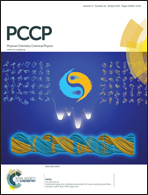p/n-Polarity of thiophene oligomers in photovoltaic cells: role of molecular vs. supramolecular properties†
Abstract
Molecular and supramolecular properties play key roles in the optoelectronic properties and photovoltaic performances of organic materials. In the present work, we show how small changes in the molecular structure affect such properties, which in turn control the intrinsic and fundamental properties such as the p/n-polarity of organic semiconductors in bulk-heterojunction solar cells. Herein, we designed and synthesized two acceptor–donor–acceptor type semiconducting thiophene oligomers end-functionalized with oxazolone/isoxazolone derivatives (OT1 and OT2 respectively). The HOMO–LUMO energy levels of both derivatives were found to be positioned in such a way that they can act as electron acceptors to P3HT and electron donors to PCBM. However, OT1 functions as a donor (with PCBM) and OT2 as an acceptor (with P3HT) in BHJ photovoltaic cells, and their reverse roles results in either no or poor performance of the cells. Detailed studies using UV-vis absorption and fluorescence spectroscopy, time-correlated single photon counting, UV-photoelectron spectroscopy, density functional theory calculations, X-ray diffraction, and thermal gravimetric analysis proved that both molecular and supramolecular properties contributed equally but in a contrasting manner to the abovementioned observation. The obtained results were further validated by flash-photolysis time-resolved microwave conductivity studies which showed an excellent correlation between the structure, property, and device performances of the materials.



 Please wait while we load your content...
Please wait while we load your content...